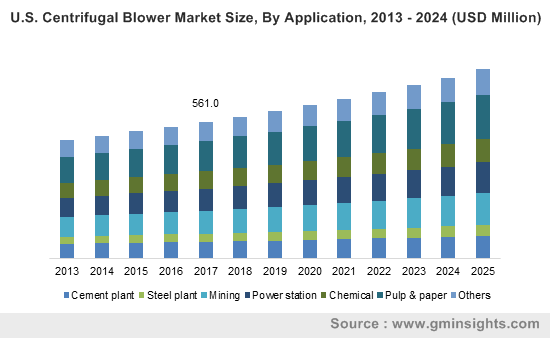Centrifugal Blower Market to amass considerable revenue via extensive product deployment across wastewater treatment plants
Publisher : Fractovia | Published Date : 2018-06-13Request Sample
Centrifugal blower market has been witnessing robust growth lately, pertaining to the product application across a slew of highly advanced industries. Renowned blower manufacturers can be aptly credited for this progress, as they strive to continuously adopt new design strategies to launch a variety of products. In addition, these big shots have also been investing in the development of next-generation products for various industrial applications, wherein they are extensively used for maintaining ventilation. To be precise, blowers are used in various industrial process to force out air or gas trapped in dampers, ducts, and other components, merely by generating pressure. The increasing use of blowers in various industrial processes is thus likely to fuel centrifugal blower industry trends over 2018-2024.
U.S. Centrifugal Blower Market Size, By Application, 2013 - 2024 (USD Million)

Manufacturing and chemical companies are widely known to develop water treatment plants in order to comply with the stringent regulatory norms related to industrial wastewater. The main motive behind the deployment of such strict regulatory norms is to reduce the impact of hazardous chemicals on biodiversity. In accordance, even municipal corporations have constructed water reclamation facilities on a large scale for handling and treating industrial, commercial, and residential wastewater, for which tech companies have developed automated and portable water treatment systems as well. The essential point of significance here is that these water treatment systems largely require centrifugal blowers to pressurize the wastewater. The treatment process is designed to remove several chemicals from the stream of wastewater – a procedure that demands high-powered blowers. The increasing deployment of wastewater treatment plants is thus a pivotal factor responsible for the growth of centrifugal blower market share.
Though the deployment of wastewater treatment plants helps to better the environment, the issue of increasing power consumption for water treatment plants has remained a debatable topic since the last few years. In response to the same, market players have now been focusing on efficiency enhancement of water treatment systems. In the United States, many companies have already implemented technology assisted centrifugal blowers to control air flow and activate inlet valves. The deployment of automated centrifugal blowers has led to minimizing the power consumption, leading to appreciable cost savings. Taking into account the cost benefits of these automated blowers, numerous municipal corporations are heavily investing in advanced water treatment systems, which will favorably drive centrifugal blower market share.
Nowadays, clean-room applications are substantively becoming more popular for delivering clean, reliable, and efficient air across myriad industries. In fact, several plant operators are increasingly relying on compressed air systems to deliver clean air solutions. However, compressed air transmission lines lead to accumulation of dust, air, and other air pollutants, which need to be cleaned on a regular basis. On these grounds, centrifugal blowers are being adopted by numerous companies for maintaining cleanliness in transmission lines, thereby impelling centrifugal blower industry outlook. The escalating demand to maintain a clean, eco-friendly working environment across industrial workplaces is thus poised to fuel centrifugal blower market size over the years ahead.
Taking into account the extensive use of blowers in numerous industrial applications, the players in centrifugal blower industry have been eyeing the development of customer-centric innovation processes. This strategy has been touted to help them extend their customer base by fulfilling the users’ unmet needs. The energy efficiency requirement could also be accomplished effectively with the development of next-generation centrifugal blowers. In addition, with the adoption of technologically advanced products, customers may also be able to combat the health hazard factor in question.
Technological developments apart, it is essential note that the maintenance costs of centrifugal blowers is rather high – a factor that may slightly restrain the industry expansion over 2017-2024. However, major contenders of market have been investing substantially in research and development activities to bring about cost-effective products.
The rise in the requirement of clean air and an energy efficient working environment across major industrial sectors including chemical, manufacturing, and paper & pulp will stimulate the demand for blowers in the years to come. Considering the growing business opportunities across the industrial domain, centrifugal blowers market players have been exclusively focusing on unique product developments. Aided by the favorable contribution of industry players and regional governments, centrifugal blower market, by the end of 2024, will surpass a revenue collection of USD 4 billion.